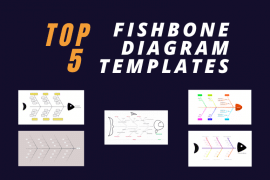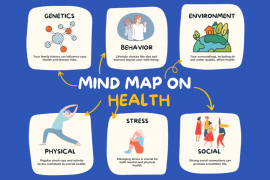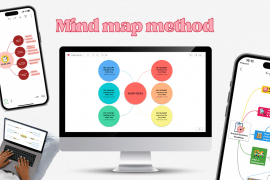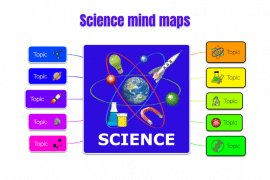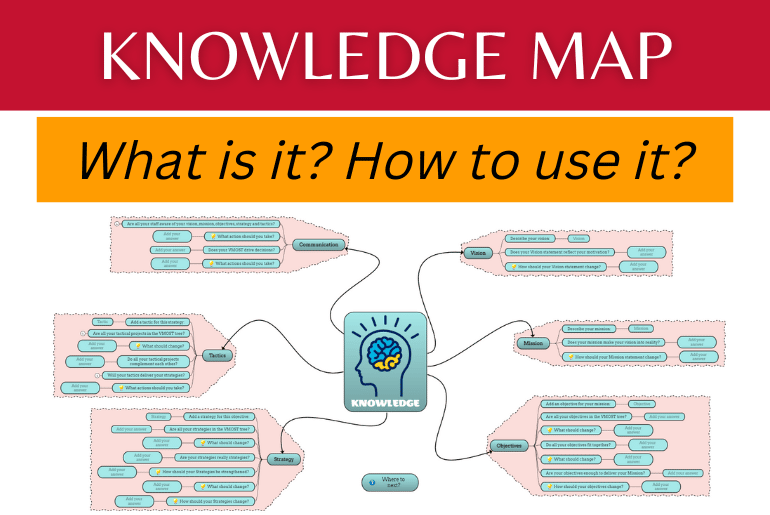
Knowledge is power. That’s why a company’s knowledge assets are some of its most valuable. But what good is it if your staff doesn’t know how to access it quickly and efficiently?
That’s where using mind maps for knowledge management can help. Knowledge maps are special mind maps. They allow you to visually organize information in a way that’s clear and easy to follow.
They can be used to represent knowledge in any domain. But they’re commonly used in business settings to help employees find important information. Forbes has featured more than one article on their value to the business world in the past few years.
So, what exactly is a mind map? And more importantly, what are some of the benefits of knowledge maps? In this blog post, we’ll answer those questions and more!
First, we’ll define what a knowledge map is and how it can be used for knowledge management. Then we’ll cover some of the situations where knowledge maps are most useful. Finally, we’ll look at how you can organize your company’s knowledge assets with a knowledge map of your very own.
What is a Knowledge Map?
A knowledge map is a mind map that clarifies knowledge assets. It also shows how they’re related using a series of lines and nodes. Those knowledge assets can take the form of files, other data, or even human resources. That’s why they’re sometimes called inventories of knowledge.
Large and small companies alike use knowledge maps because they’re excellent at organizing all kinds of internal data. But that’s only part of their value. They also streamline an organization’s overall project management processes, help staff identify knowledge gaps, and more.
Here’s an example of a knowledge map that offers an overview of a new product’s launch.

Ultimately, a knowledge map’s design is dependent on how it’s going to be used to organize your thoughts. With that said, most knowledge maps can be categorized in one of three ways.
1. Procedural Knowledge Map
A procedural knowledge map shows processes, including anything from a manufacturing process to onboarding new hires. They typically take the form of a flowchart diagram that can be followed step by step.
Procedural knowledge maps are helpful because they offer a big picture view of the process. But they never lose sight of the individual steps required to make it happen. That way, you don’t miss the forest for the trees – or vice versa. This is why they’re a great tool for project management, training new employees, or documenting quality control processes. Situations where a procedural knowledge map would be useful include:
- Outlining the steps of a manufacturing or software development process
- Outlining steps for staff to take when dealing with customer service issues
- Detailing the onboarding process for new hires
2. Conceptual Knowledge Maps
Conceptual knowledge maps focus on relationships between concepts. Rather than documenting processes, they show how ideas are related.
Conceptual knowledge maps are beneficial because they offer a high-level overview of a topic. This can be useful for exploring new ideas or for getting a quick refresher on a complex topic. Situations where a conceptual knowledge map would be useful include:
- Brainstorming ideas for a product or service
- Mapping out relationships between different departments in your company
3. Competency Knowledge Maps
Competency mind maps are similar to conceptual knowledge maps. But they focus specifically on the skills and competencies required to do a job. They’re often used for training and development purposes. They’re also a great tool for putting teams together.
A competency map shows a clear overview of the skills required to do a job well. This can be useful for identifying training and development needs, identifying knowledge gaps, and more. Situations where a competency map would be useful include:
- Identifying training and development needs
- Creating clear job descriptions
Why Should You Use a Knowledge Map?
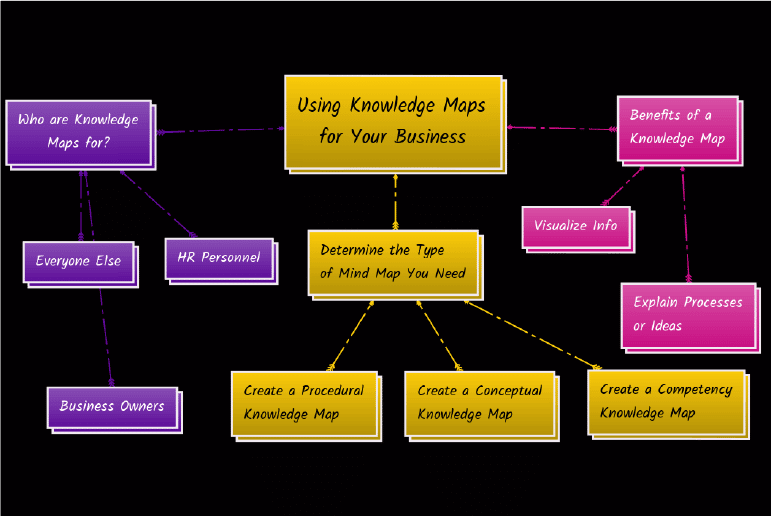
There are dozens of benefits of knowledge maps. However, the most basic reasons go back to the three kinds of knowledge maps out there.
To get an overview of a topic. Knowledge maps can offer a high-level view of relationships between ideas or other knowledge assets. This can be helpful when you’re trying to understand a complex topic or exploring new ideas. For businesses, this is particularly helpful when it comes to product development and similar processes.
To understand how a process works. Since knowledge maps can offer a step by step view of a process, they’re helpful for better understanding it. This is valuable for increasing efficiency, particularly when it comes to customer service and manufacturing processes.
To identify training and development needs. Knowledge maps offer a clear overview of the competencies, training, and skills needed to succeed at a job. This can be especially helpful for improving your staff and teams.
Creating a Knowledge Map Made Easy
We’ve answered the questions, “What is a mind map?” and “Why should I use one for my business?” Now, it’s time to learn how to craft a useful knowledge map step by step.
Fortunately, you don’t have to get out your pen and paper (or whiteboard) to create a knowledge map. You can create and customize a diagram using an online mind map software. Some of these solutions are paid, while others are open source.
One of the best apps is Mindomo. It’s one of the most powerful knowledge mapping tools out there. But it’s not limited to knowledge mapping. It can also be used to create a variety of other diagrams. With Mindomo, you can quickly and easily put together concept maps, outlines, Gantt charts, and more.
Once you’ve chosen how you’re creating a knowledge map, you need to decide what kind of mind maps you need. As we’ve seen, there are three primary kinds of knowledge maps: procedural, conceptual, and competency. Once you’ve settled on the type of mind maps you need, creating them will be that much easier.
Creating a Procedural Knowledge Map
If you need a procedural knowledge map, start by documenting the steps in the process. Include as many details as possible so that it’s easy to follow. Then, create a flowchart that outlines the steps in order. If you’re using digital knowledge mapping tools, you should be able to attach images, documents, or other files as well.
Creating a Conceptual Knowledge Map
To put together a conceptual knowledge map, begin with a single big idea. Then, brainstorm any related ideas, exploring the various relationships between them as you go. How are they connected? What is the importance of each concept? Connect them using your mind mapping software and add any necessary details as you go.
Creating a Competency Knowledge Map
If you need a competency knowledge map, start by brainstorming a list of skills and competencies required for the job. Then, explore the relationship between these skills and competencies. What is the importance of each one? How do they work together? You might also want to think about how the position at hand will function with others in the organization.
Start creating your own knowledge maps and benefit from their use in your business.
Keep it smart, simple, and creative!
The Mindomo Team



